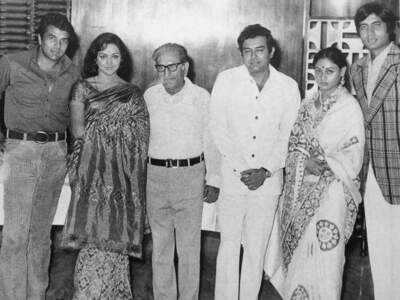Every cult classic has its legend, and behind one of India's most renowned films, Sholay, stood a man whose own life story was nothing short of iconic. Gopaldas Parmanand Sippy, fondly known as GP Sippy, was the visionary producer who brought Sholay to life. But few know that long before he became a pillar of Bollywood, he was a displaced survivor of Partition, forced to rebuild from the scratch.
How GP Sippy rose from being homeless to film legend
Born into a wealthy business family in Karachi, Sippy’s life changed drastically after India’s Partition in 1947. His family was forced to leave everything behind, their mansion, thriving businesses, and wealth, when they fled overnight to Bombay (now Mumbai).

According to a New York Times report, the family arrived with little more than hope. In Bombay, survival was far from easy. Sippy tried various small ventures. From opening a restaurant in Bombay to selling carpets, he then moved to construction work and build some of the first apartments buildings in Bombay.
While building a house for Bollywood actress Nargis Dutt, GP Sippy became interested in films. He tried acting for a short time and later began producing low-budget crime movies. As he mingled with Bombay’s people, Sippy was often encouraged to venture into films.
In 1953, he made his debut as a producer with Sazaa. While the film didn't make waves, it marked the start of his long relationship with cinema. Over the next few years, Sippy invested in several films and even dabbled in direction and acting. However, limited box office success saw him being labelled a B-grade producer.
Realising the need for fresh perspective, he brought his son Ramesh Sippy back from the London School of Economics to take charge of the business. The turning point came in 1975 with the release of Sholay. Directed by Ramesh and written by the powerhouse duo Salim-Javed, Sholay redefined Indian cinema.
Sholay is arguably the iconic film of Indian cinema, featuring an all-star cast led by Amitabh Bachchan, Dharmendra, Hema Malini, Jaya Bhaduri, Sanjeev Kumar and the unforgettable Amjad Khan as Gabbar Singh. With a budget of Rs 3 crore, a huge sum at the time, the film introduced larger-than-life storytelling, iconic characters, and unforgettable dialogues. It ran in cinemas for five years and became a cultural phenomenon. And still is!
More about GP Sippy's filmography
Sippy followed this with other major productions like Shaan, Seeta Aur Geeta, Saagar (which marked Dimple Kapadia’s return), Raju Ban Gaya Gentleman, and Patthar Ke Phool. His eye for narratives and commercial credibility helped shape Bollywood's golden era.
GP Sippy passed away in 2007 at the age of 93. His legacy lives on not only through Sholay but how he redefined Indian cinema.
How GP Sippy rose from being homeless to film legend
Born into a wealthy business family in Karachi, Sippy’s life changed drastically after India’s Partition in 1947. His family was forced to leave everything behind, their mansion, thriving businesses, and wealth, when they fled overnight to Bombay (now Mumbai).
According to a New York Times report, the family arrived with little more than hope. In Bombay, survival was far from easy. Sippy tried various small ventures. From opening a restaurant in Bombay to selling carpets, he then moved to construction work and build some of the first apartments buildings in Bombay.
While building a house for Bollywood actress Nargis Dutt, GP Sippy became interested in films. He tried acting for a short time and later began producing low-budget crime movies. As he mingled with Bombay’s people, Sippy was often encouraged to venture into films.
In 1953, he made his debut as a producer with Sazaa. While the film didn't make waves, it marked the start of his long relationship with cinema. Over the next few years, Sippy invested in several films and even dabbled in direction and acting. However, limited box office success saw him being labelled a B-grade producer.
Realising the need for fresh perspective, he brought his son Ramesh Sippy back from the London School of Economics to take charge of the business. The turning point came in 1975 with the release of Sholay. Directed by Ramesh and written by the powerhouse duo Salim-Javed, Sholay redefined Indian cinema.
Sholay is arguably the iconic film of Indian cinema, featuring an all-star cast led by Amitabh Bachchan, Dharmendra, Hema Malini, Jaya Bhaduri, Sanjeev Kumar and the unforgettable Amjad Khan as Gabbar Singh. With a budget of Rs 3 crore, a huge sum at the time, the film introduced larger-than-life storytelling, iconic characters, and unforgettable dialogues. It ran in cinemas for five years and became a cultural phenomenon. And still is!
More about GP Sippy's filmography
Sippy followed this with other major productions like Shaan, Seeta Aur Geeta, Saagar (which marked Dimple Kapadia’s return), Raju Ban Gaya Gentleman, and Patthar Ke Phool. His eye for narratives and commercial credibility helped shape Bollywood's golden era.
GP Sippy passed away in 2007 at the age of 93. His legacy lives on not only through Sholay but how he redefined Indian cinema.
You may also like

Kuwait's College of Applied Sciences to start admitting non-Kuwaiti students: Key details you need to know

I went to one of UK's worst seaside towns for the first time — it blew me away

Top jockey's tribute to superstar racehorse as champion's grave is officially opened to public

Millions of savers to face unexpected tax bills

Health Tips: What are the benefits of having dinner between 7-8 in the night, what happens if you eat after that..






